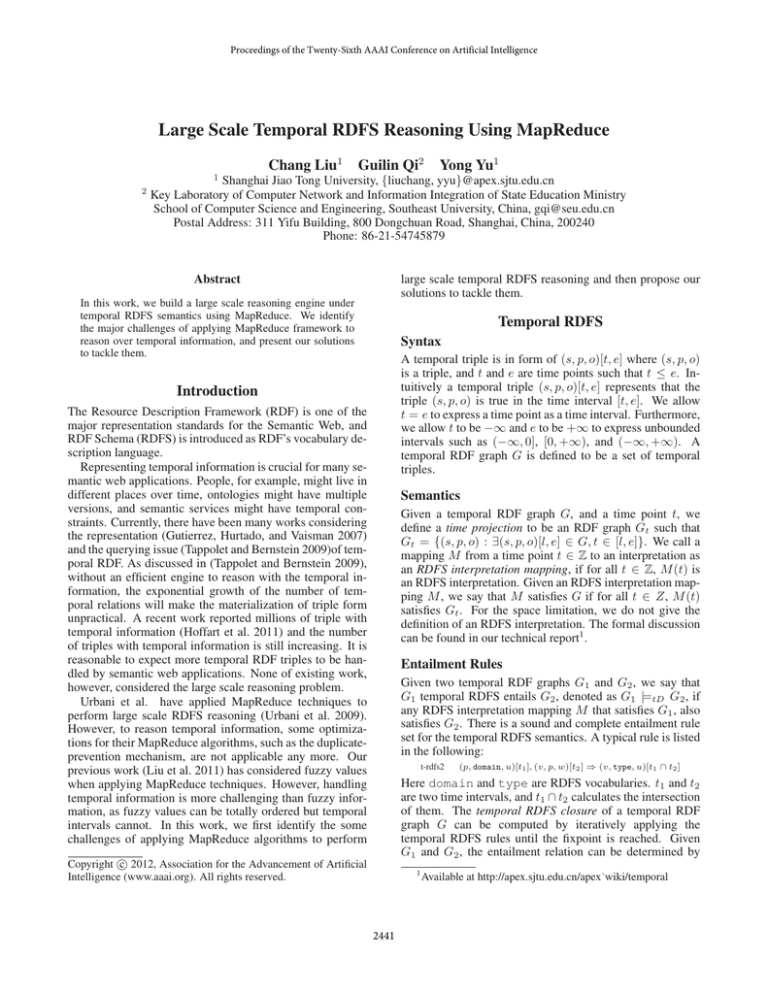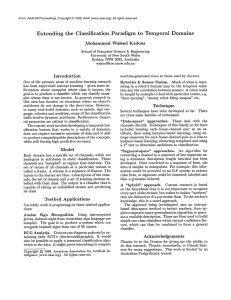
Proceedings of the Twenty-Sixth AAAI Conference on Artificial Intelligence
Large Scale Temporal RDFS Reasoning Using MapReduce
Chang Liu1
Guilin Qi2
Yong Yu1
1
2
Shanghai Jiao Tong University, {liuchang, yyu}@apex.sjtu.edu.cn
Key Laboratory of Computer Network and Information Integration of State Education Ministry
School of Computer Science and Engineering, Southeast University, China, gqi@seu.edu.cn
Postal Address: 311 Yifu Building, 800 Dongchuan Road, Shanghai, China, 200240
Phone: 86-21-54745879
Abstract
large scale temporal RDFS reasoning and then propose our
solutions to tackle them.
In this work, we build a large scale reasoning engine under
temporal RDFS semantics using MapReduce. We identify
the major challenges of applying MapReduce framework to
reason over temporal information, and present our solutions
to tackle them.
Temporal RDFS
Syntax
A temporal triple is in form of (s, p, o)[t, e] where (s, p, o)
is a triple, and t and e are time points such that t ≤ e. Intuitively a temporal triple (s, p, o)[t, e] represents that the
triple (s, p, o) is true in the time interval [t, e]. We allow
t = e to express a time point as a time interval. Furthermore,
we allow t to be −∞ and e to be +∞ to express unbounded
intervals such as (−∞, 0], [0, +∞), and (−∞, +∞). A
temporal RDF graph G is defined to be a set of temporal
triples.
Introduction
The Resource Description Framework (RDF) is one of the
major representation standards for the Semantic Web, and
RDF Schema (RDFS) is introduced as RDF’s vocabulary description language.
Representing temporal information is crucial for many semantic web applications. People, for example, might live in
different places over time, ontologies might have multiple
versions, and semantic services might have temporal constraints. Currently, there have been many works considering
the representation (Gutierrez, Hurtado, and Vaisman 2007)
and the querying issue (Tappolet and Bernstein 2009)of temporal RDF. As discussed in (Tappolet and Bernstein 2009),
without an efficient engine to reason with the temporal information, the exponential growth of the number of temporal relations will make the materialization of triple form
unpractical. A recent work reported millions of triple with
temporal information (Hoffart et al. 2011) and the number
of triples with temporal information is still increasing. It is
reasonable to expect more temporal RDF triples to be handled by semantic web applications. None of existing work,
however, considered the large scale reasoning problem.
Urbani et al. have applied MapReduce techniques to
perform large scale RDFS reasoning (Urbani et al. 2009).
However, to reason temporal information, some optimizations for their MapReduce algorithms, such as the duplicateprevention mechanism, are not applicable any more. Our
previous work (Liu et al. 2011) has considered fuzzy values
when applying MapReduce techniques. However, handling
temporal information is more challenging than fuzzy information, as fuzzy values can be totally ordered but temporal
intervals cannot. In this work, we first identify the some
challenges of applying MapReduce algorithms to perform
Semantics
Given a temporal RDF graph G, and a time point t, we
define a time projection to be an RDF graph Gt such that
Gt = {(s, p, o) : ∃(s, p, o)[l, e] ∈ G, t ∈ [l, e]}. We call a
mapping M from a time point t ∈ Z to an interpretation as
an RDFS interpretation mapping, if for all t ∈ Z, M (t) is
an RDFS interpretation. Given an RDFS interpretation mapping M , we say that M satisfies G if for all t ∈ Z, M (t)
satisfies Gt . For the space limitation, we do not give the
definition of an RDFS interpretation. The formal discussion
can be found in our technical report1 .
Entailment Rules
Given two temporal RDF graphs G1 and G2 , we say that
G1 temporal RDFS entails G2 , denoted as G1 |=tD G2 , if
any RDFS interpretation mapping M that satisfies G1 , also
satisfies G2 . There is a sound and complete entailment rule
set for the temporal RDFS semantics. A typical rule is listed
in the following:
t-rdfs2
(p, domain, u)[t1 ], (v, p, w)[t2 ] ⇒ (v, type, u)[t1 ∩ t2 ]
Here domain and type are RDFS vocabularies. t1 and t2
are two time intervals, and t1 ∩ t2 calculates the intersection
of them. The temporal RDFS closure of a temporal RDF
graph G can be computed by iteratively applying the
temporal RDFS rules until the fixpoint is reached. Given
G1 and G2 , the entailment relation can be determined by
c 2012, Association for the Advancement of Artificial
Copyright Intelligence (www.aaai.org). All rights reserved.
1
2441
Available at http://apex.sjtu.edu.cn/apex˙wiki/temporal
checking if G2 is a subgraph of the temporal RDFS closure
of G1 .
key/value pairs generated by mappers with the same key into
the memory. If there are too many values, e.g., the number
of (v, w) for a given p is too large, the reducer can easily
fail.
We find that in the condition of each of these rules, there
is at least one temporal triple that is a schema triple. In practice, we can assume that the number of schema triples is
relatively small. Therefore, we can load them into the memory, and perform the join in the mappers such that we can
avoid the above two drawbacks.
Large Scale Temporal RDFS Reasoning
We are able to encode a temporal RDFS entailment rule into
a MapReduce program similar to the treatment of RDFS
entailment rules given in (Urbani et al. 2009). This kind
of implementation, however, will suffers some challenging
problems which make the large scale temporal reasoning impossible. In this section, we first identify these challenging
problems, and then we present our solutions to tackle them.
Calculating the class and property hierarchy
Duplicates The straightforward implementations will result in many duplicates. As a result, the graph will expand
greatly. Storing the huge size of graph may lead to both a
waste of storage space and a waste of computation time. The
same problem appears when dealing with two fuzzy triples
with the same triple part. For fuzzy domain, we can simply
store the larger fuzzy degree. For temporal domain, however, there is no full order so that we are not always able to
compare two time intervals. In the following we will introduce a compact representation of the time intervals to tackle
this problem.
It is easy to see that rule t-rdfs11 needs to recursively calculate the transitive closure of sc triples, e.g. triples with sc
as their predicates. However, since they are schema triples,
as we have discussed previously, we can load them into the
memory in order to avoid the reiterative execution of the
MapReduce program of rule t-rdfs11. Furthermore, we can
see that calculating the sc closure by applying rule t-rdfs11
is indeed a variation of the all-pairs shortest path calculation
problem. We can develop an algorithm to calculate the closure within O(n4 ) where n is the number of sc triples. Even
though the complexity seems a little high, the algorithm runs
very fast in real applications.
Efficient Implementation The naive implementation will
encounter some problems and violate the principles to develop efficient MapReduce programs. For example, the
naive implementation of rule t-rdfs2 will introduce an unnecessary shuffling process and will treat the values in the
reduce function as a set instead of a stream.
In this work, we presented the first work to handle the problem of large scale temporal RDFS reasoning using MapReduce. We identified some unique challenges and gave solutions to tackle them. In the future, we will conduct experiments to study the performance of our engine.
Challenges and solution
Conclusion
Shortest Path Calculation In temporal RDFS semantics,
there are two rules, i.e. t-rdfs5 (subproperty) and t-rdfs11
(subclass), that require iterative calculations. When we treat
each temporal triple as a weighted edge in the RDF graph,
calculating the closure by applying these two rules is essentially a variation of the all-pairs shortest path calculation
problem. Unlike the fuzzy domain which has a total order,
the domain of time interval has only a partial order. Thus,
we need to design new efficient algorithms for this problem.
Acknowledgement
Guilin Qi is partially supported by NSFC (61003157),
Jiangsu Science Foundation (BK2010412), Excellent Youth
Scholars Program of Southeast University, and Doctoral
Discipline Foundation for Young Teachers in the Higher
Education Institutions of Min- istry of Education (No.
20100092120029).
References
Compact Representation
Gutierrez, C.; Hurtado, C. A.; and Vaisman, A. 2007. Introducing time into rdf. In Proc. of TKDE’ 07, 207 – 218.
Hoffart, J.; Suchanek, F. M.; Berberich, K.; Lewis-Kelham,
E.; de Melo, G.; and Weikum, G. 2011. Yago2: exploring
and querying world knowledge in time, space, context, and
many languages. In Proc. of WWW’ 11, 229–232.
Liu, C.; Qi, G.; Wang, H.; and Yu, Y. 2011. Large scale
fuzzy pD∗ reasoning using mapreduce. In Proc. of ISWC’
11, 405–420.
Tappolet, J., and Bernstein, A. 2009. Applied temporal rdf:
Efficient temporal querying of rdf data with sparql. In Proc.
of ESWC’ 09, 308–322.
Urbani, J.; Kotoulas, S.; Oren, E.; and Harmelen, F. V. 2009.
Scalable distributed reasoning using mapreduce. In Proc. of
ISWC’ 09, 374 – 389.
We use a compact representation to store temporal triples.
Given a set of temporal triple (s, p, o)[ti , ei ], for i = 1, ..., k
such that ti ≤ ei < ti+1 holds for all 1 ≤ i < k, we store
them as (s, p, o)[l] where l = (t1 , e1 ), ..., (tk , ek ). Furthermore t1 can be −∞ and ek is allowed to be +∞. We call l
a compound time interval.
In such compact representation, the intersection and
union operations of two compound time intervals can be implemented by algorithms with linear time complexity.
Loading schema triples into memory
As discussed above, a rule, e.g. t-rdfs2, can be encoded
into a MapReduce program. However, there are two drawbacks in the naive implementation. Firstly, there is a very expensive shuffling process before the reducers are launched.
Secondly, in each reducer, we have to load all values of
2442







